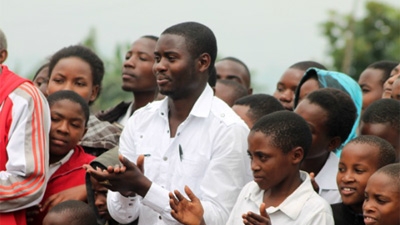Priority to the most vulnerable communities
This emergency work is the result of the World Bank’s commitment to rapid aid for reconstruction of the eastern region of the DRC, ravaged by many years of war. A US$6 million advance will fund preparatory work for the Eastern Region Stabilization and Peace-Building Project (STEP), which seeks to stabilize vulnerable communities in North and South Kivu, as well as in the Ituri, Bas-Uélé and Haut-Uélé districts in Orientale Province. Special attention will be paid to those hardest hit by the conflict, such as the internally displaced and their host communities, at-risk youth, and women.
STEP also seeks to reinforce the new prospects for peace and economic recovery. Addressing the collateral effects of the war, it will aid in economic reintegration, support repair and construction of community infrastructure, and help the population groups impacted by the war to rebound. “Vulnerable communities are our top priority,” says Maurizia Tovo, the World Bank’s task team leader.
To achieve its objectives, the project focuses on three aspects of recovery: community-building and better access to basic socioeconomic services; job creation to boost income among vulnerable population groups; and strengthening the capabilities of provincial authorities and entities.
The STEP project is only one aspect of a more ambitious initiative the World Bank plans to implement in this region of the DRC. During a visit to the Great Lakes region last May, the president of the World Bank Group, Jim Yong Kim, traveling with United Nations Secretary-General Ban Ki-moon, announced the provision of US$1 billion in funding to help countries in the region improve their health and education services, increase cross-border trade, and finance hydroelectric projects.
For Jim Yong Kim, this funding was important to help revitalize economic development, create jobs, and improve the lives of people who have suffered far too long.
“The leaders of the Great Lakes region, by relaunching economic activity and improving living conditions in border areas, can now restore confidence, build the economy, and give new opportunities to millions of people,” he stated during his visit to the region.
By July 2014, roughly half of the $1 billion will be committed, with the rest on schedule for commitment over the next 12 months.
In the DRC, adding funds from the Great Lakes Initiative to the World Bank’s existing national program funding will produce a greater impact and better response to people’s needs.
Back in North Kivu, Country Director Eustache Ouayoro repeats President Kim’s message and reiterates the World Bank’s support for the peace-building process. “Our presence here attests to our commitment to stand beside you and provide assistance to reconstruct this beautiful province.”
The promise of a brighter future
In the territories of Rutshuru and Nyiragongo, as well as in Goma, emergency work will entail 33 new community infrastructure subprojects for such basic social services as schools, health centers, drinking water, electricity, and agricultural service roads. The work is expected to be completed by March 15, 2014.
“It is important for this work to be completed quickly if it is to have meaningful impact for people,” says Ouayoro. “We want to do the work quickly but well, which makes all the difference. Schools will be built, but students also need books and even Internet access. Our program should serve as a model.”
These subprojects, to be executed by the DRC’s Social Fund, were proposed by the beneficiaries, who in this way participate in the reconstruction of their communities and take charge of their own destinies. In Majengo (one of the poorest neighborhoods in Goma), for example, the communities opted for electricity. On Monday, December 17, its residents experience the same exuberance seen in Bunagana and Kibumba. A new power line is being installed that will finally allow the neighborhood to have electricity. “We have been in the dark for many years, which led to insecurity and rape,” said Kubuya Ndole, the town’s mayor.
“Now we can walk around safely, and small shops will finally operate again,” adds Georgette Kitambala, a representative of the beneficiaries.
The din of construction work will now replace the sounds of war, and hammers will be heard instead of guns. In some sense, these new schools, health centers, and water supply projects represent much more than mere infrastructure—they are the pillars on which community cooperation will be rebuilt.
“Our programs are designed to foster joint work,” says Ouayoro. “Community participation is essential to mending the social fabric.”
Although the word “suffering” is often heard when years of war are described, the dignity, courage and dynamism of the people is striking in Bunagana, Kibumba and Goma. “Even during the war, agriculture was thriving,” says Monsignor Théophile Kaboyi, the bishop of Goma.
After leaving Goma, a vivid image remains of the children at the small school in Kibumba, standing in the driving rain and singing the DRC national anthem, which alludes to solidarity, a country rebuilt to be more beautiful than before, a climate of peace, and a pledge for a lasting legacy of freedom. Here, in the verdant hills of Nyiragongo, the words take on their full significance, a clear promise of a brighter future.

